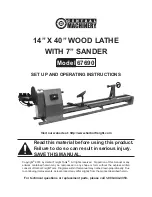
20
Figure 10-7: coves
"V" Cuts
1. Use the long point of the skew. (NOTE: Do not
press the long point of the skew directly into the
workpiece to create the "V"; this will result in a
burned or burnished "V" with fibers being rolled
up at both sides.)
2. Lightly mark the center of the "V" with the tip of
the skew.
3. Move the point of the skew to the right half of
the desired width of your cut.
4. With the bevel parallel to the right side of the
cut, raise the handle and push the tool in to the
desired depth, as shown in Figure 10-8.
Figure 10-8: V-cuts
5. Repeat from the left side. The two cuts should
meet at the bottom and leave a clean "V" cut.
6. Additional cuts may be taken to add to either the
depth or width of the cut.
Parting Off
1. Use parting tool.
2. Adjust lathe speed to lower RPM for parting
through a workpiece.
3. Place tool on tool support and raise the handle
until it starts to cut and continue to cut toward
the center of the workpiece.
4. Loosely hold on to the piece in one hand as it
separates from the waste wood.
Sanding and Finishing
Leaving clean cuts will reduce the amount of
sanding required. Move the tool support out of the
way, adjust the lathe to a
low speed
, and begin with
fine sandpaper (120 grit or finer). Coarser
sandpaper will leave deep scratches that are difficult
to remove, and dull crisp details on the spindle.
Progress through each grit without skipping grits (for
example, do not jump from 120 grit to 220 grit). Fold
the sandpaper into a pad; do not wrap sandpaper
around your fingers or the workpiece.To apply a
finish, the workpiece can be left on the lathe.
Turn off the lathe and use a brush or paper towel to
apply the finish. Remove excess finish before
restarting lathe. Allow to dry and sand again with
320 or 400 grit sandpaper. Apply second coat of
finish and buff.
10.4
Face plate and bowl turning
Face plate turning is normally done on the inboard
side of the headstock over the bed. Larger
workpieces must be turned on the outboard side
(remove tailstock and tool support base, and move
headstock to opposite end of bed - see Figure 6-7).
10.4.1
Mounting stock
Use of a face plate is the most common method for
holding a block of wood for turning bowls and plates:
1. Select stock at least 1/8" to 1/4" larger than
each dimension on the finished workpiece.
2. Always select the largest diameter face plate
that can be used for the workpiece to be turned.
3. True one surface of the workpiece for mounting
against the face plate.
4. Using the face plate as a template, mark the
location of the mounting holes on the
workpiece, and drill pilot holes of the
appropriate size. Face plates are drilled for No.
12 screws. (Phillips and square drive screws
will hold up better than slotted screws. Sheel
metal screws are case hardened with deeper
and sharper threads than wood screws.)
If the mounting screws on the face plate interfere
with the workpiece, a glue or waste block can be
used:
5. Make a block the same diameter as the face
plate, Figure 10-9. Both waste block and
workpiece should have flat surfaces for gluing.
6. Glue the block to the workpiece. Avoid using
brown paper or newspaper between the waste
block and workpiece. It may work fine if you are
using scrapers, but a slight catch with a bowl
gouge can separate the two.
Summary of Contents for 3520C
Page 27: ...27 15 1 1 3520C Headstock Assembly Exploded View ...
Page 32: ...32 15 4 1 Bed Banjo and Tailstock Assembly Exploded View ...
Page 38: ...38 15 9 1 Optional Accessories 6294901 Lamp Holder Set exploded view ...
Page 40: ...40 16 0 Electrical connections for 1353001 3520C Lathe 16 1 Wiring diagram 1 of 2 ...
Page 41: ...41 16 2 Wiring diagram 2 of 2 B2 B1 U V W S L2 R L1 1 3 2 4 ...
Page 43: ...43 This page intentionally left blank ...
Page 44: ...44 427 New Sanford Road LaVergne Tennessee 37086 Phone 800 274 6848 www powermatic com ...












































